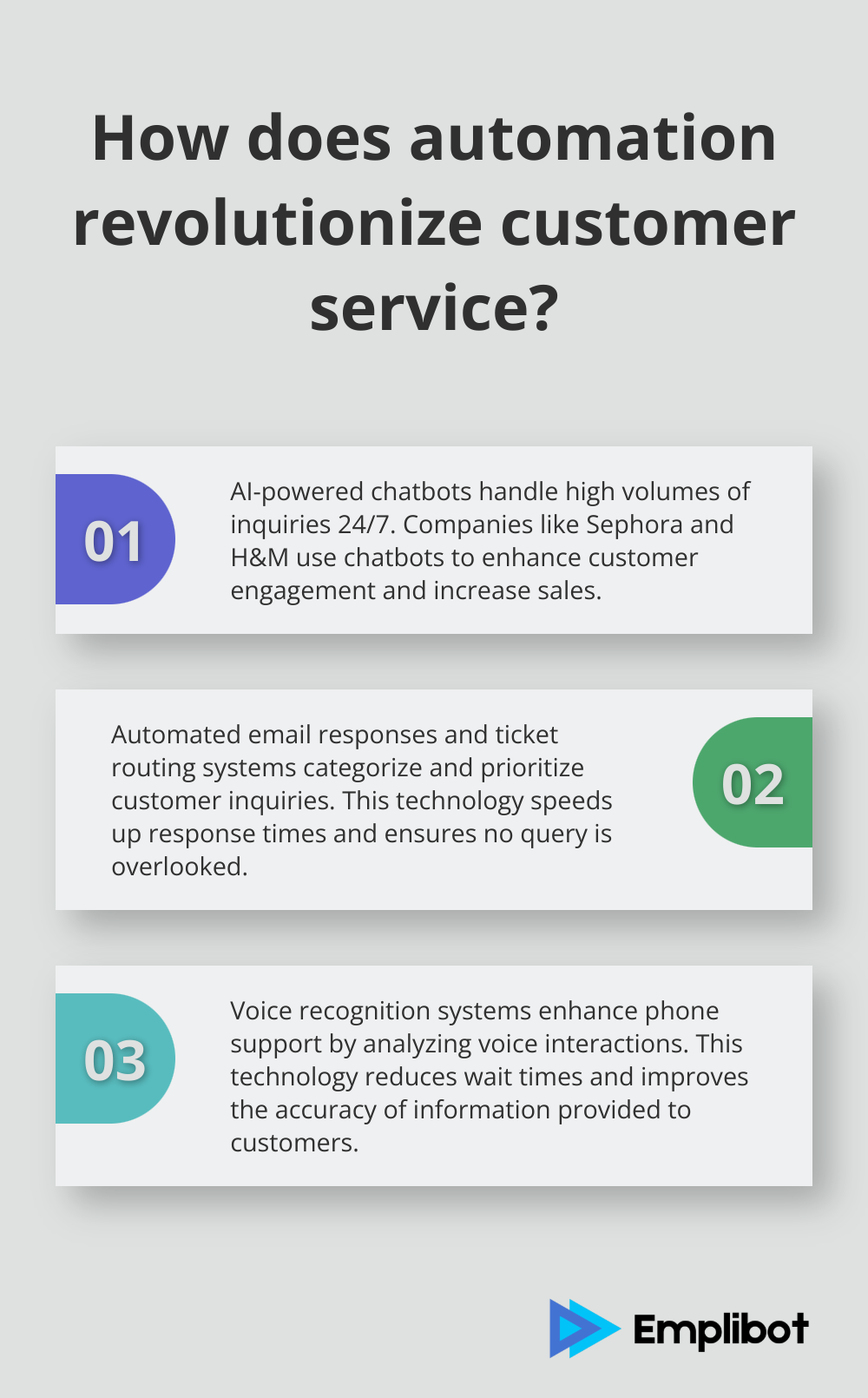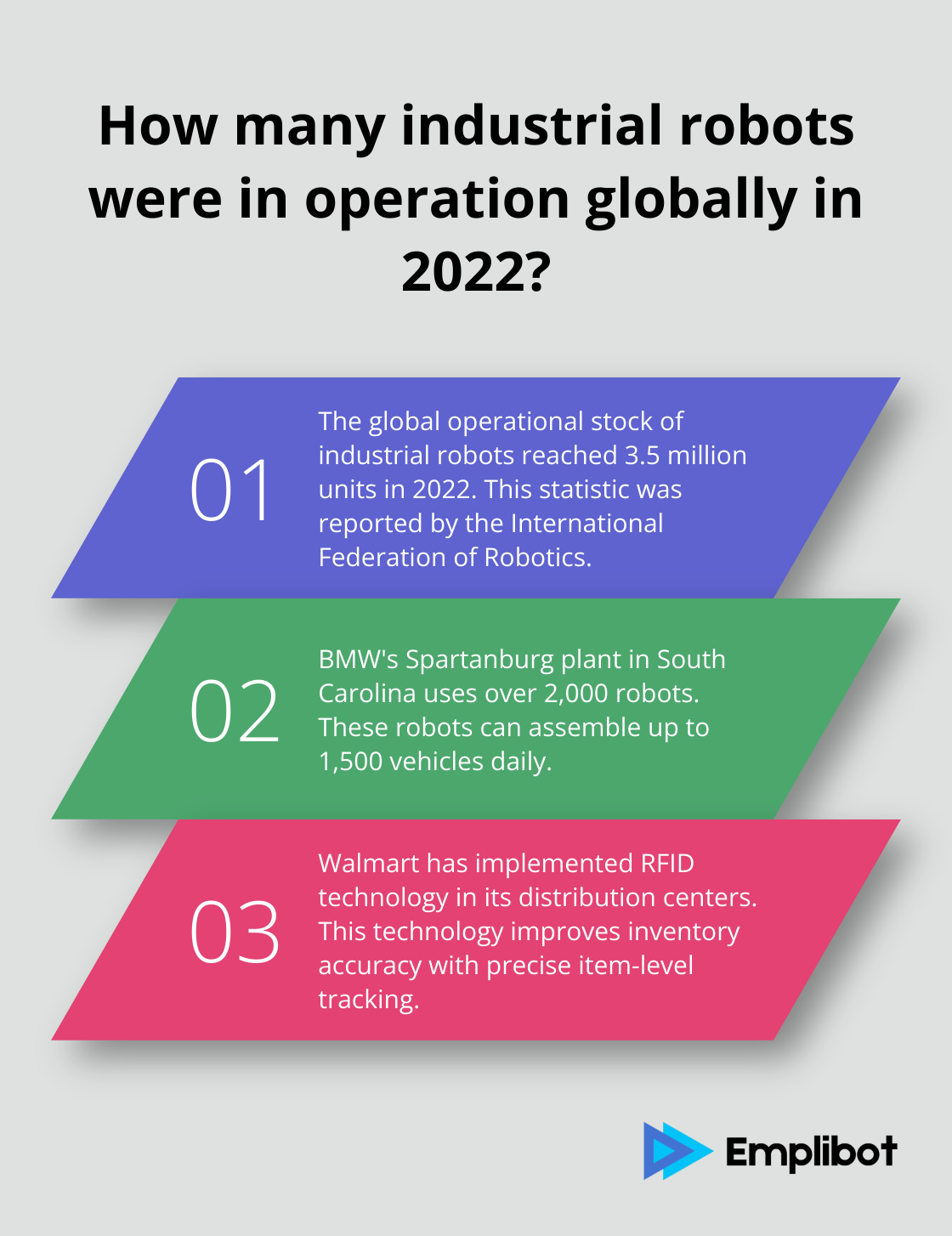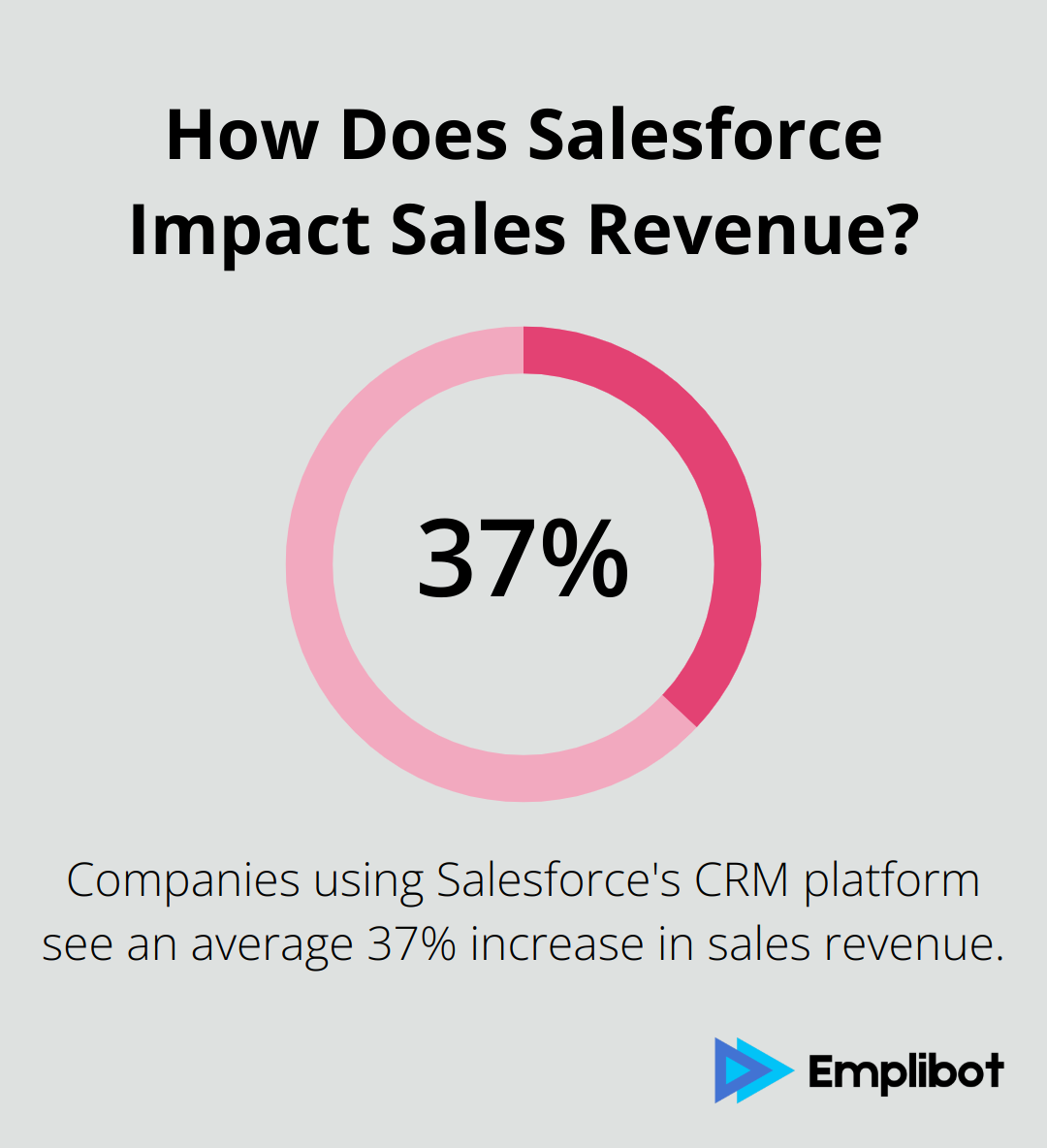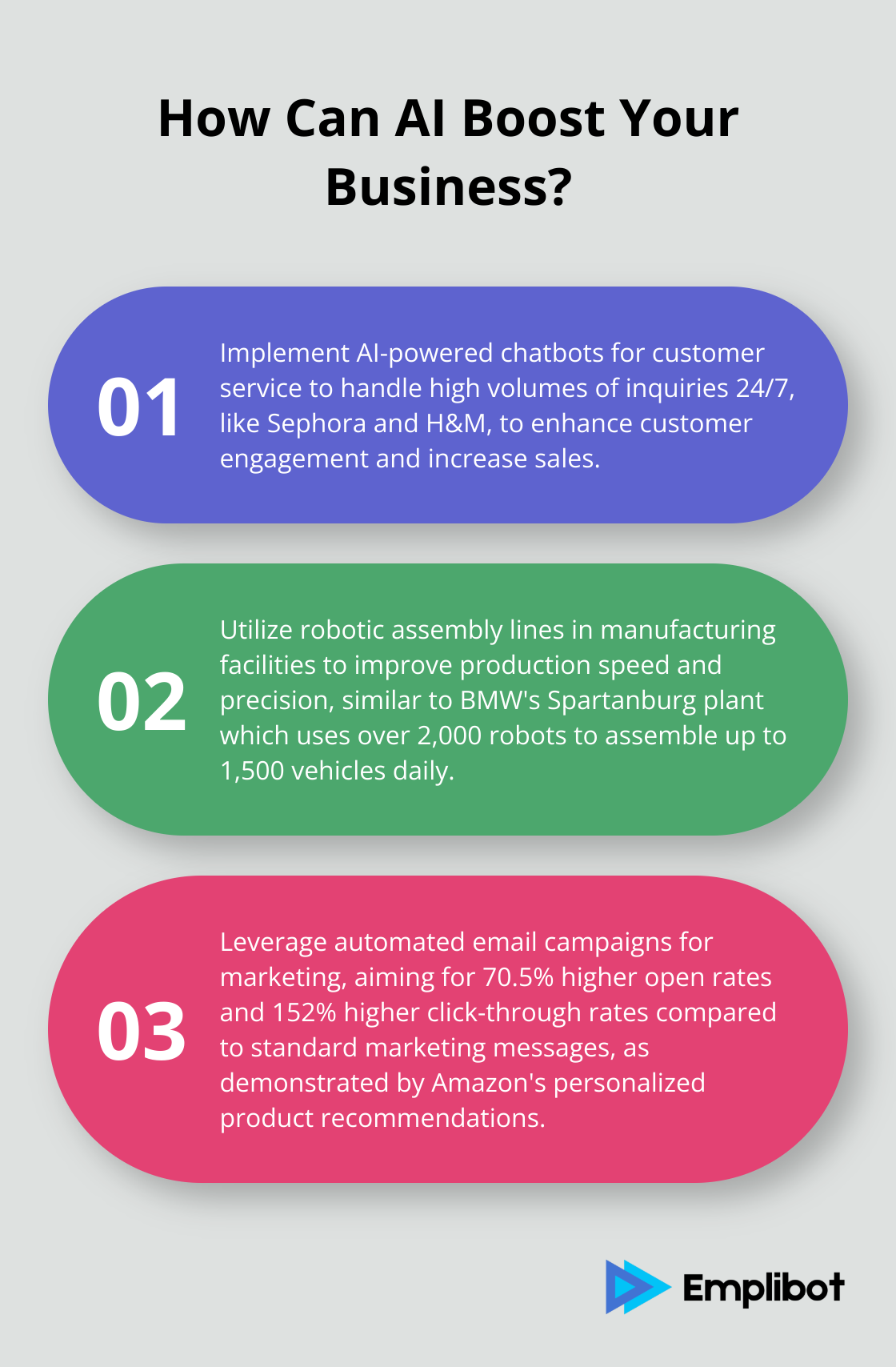Automation is revolutionizing the way businesses operate across industries. From customer service to manufacturing and marketing, companies are leveraging technology to streamline processes and boost efficiency.
At Emplibot, we’ve seen firsthand how examples of automation in business can transform operations and drive growth. In this post, we’ll explore some of the most impactful applications of automation in today’s business landscape.
How Can Automation Transform Customer Service?
Customer service automation reshapes how businesses interact with their clients. This technology provides faster, more efficient support while freeing up human agents for complex issues.
AI-Powered Chatbots: The New Frontline
AI-powered chatbots have become a game-changer in customer service. These virtual assistants handle a high volume of inquiries simultaneously, providing instant responses 24/7. Companies like Sephora and H&M have successfully implemented chatbots to enhance customer engagement, assist with product recommendations, and increase sales.
Automated Emails and Ticket Routing: Streamlining Support
Automated email responses and ticket routing systems have revolutionized how businesses manage customer inquiries. These systems categorize and prioritize incoming requests, ensuring that each issue is directed to the most appropriate department or agent. This technology not only speeds up response times but also ensures that no customer query is overlooked.
Voice Recognition: Enhancing Phone Support
Voice recognition systems have taken phone support to new heights. This technology helps sales teams work smarter by analyzing voice interactions, uncovering customer needs, and improving pitches. It reduces wait times and improves the accuracy of information provided to customers.
Striking the Right Balance
While automation in customer service offers numerous benefits, it’s important to strike a balance between automated and human interactions. The goal should be to use automation to enhance (not replace) the human touch in customer service. As businesses continue to adopt these technologies, we can expect to see even more innovative applications that further improve the customer experience.

As we move forward, let’s explore how automation is transforming another critical area of business operations: manufacturing and production.
How Is Automation Reshaping Manufacturing?
Manufacturing and production have undergone a significant transformation due to automation technologies. These advancements have revolutionized traditional assembly lines, quality control processes, and inventory management systems, leading to increased efficiency and productivity.
The Rise of Robotic Assembly Lines
Robotic assembly lines have become increasingly prevalent in manufacturing facilities worldwide. The International Federation of Robotics reports that the global operational stock of industrial robots reached 3.5 million units in 2022. This technology has dramatically improved production speed and precision. BMW’s Spartanburg plant in South Carolina uses over 2,000 robots to assemble up to 1,500 vehicles daily, showcasing the immense potential of automated manufacturing.
Enhancing Quality Control through Automation
Automated quality control systems have significantly improved product consistency and reduced defects in manufacturing. These systems use advanced sensors, machine vision, and AI algorithms to detect even the smallest imperfections. Tesla’s Fremont factory employs a network of cameras and sensors to inspect every vehicle component, ensuring high-quality standards are met consistently.
Smart Inventory Management
Smart inventory management systems have transformed how manufacturers track and manage their stock. These systems use RFID tags, IoT sensors, and AI-powered analytics to provide real-time inventory visibility and automate reordering processes. Walmart has implemented RFID technology in its distribution centers, improving inventory accuracy with precise item-level tracking.
The Impact on Workforce and Skills
The rise of automation in manufacturing has led to a shift in workforce requirements. While some jobs have been replaced by machines, new roles have emerged that require skills in operating, maintaining, and programming automated systems. This transition highlights the importance of continuous learning and upskilling in the manufacturing sector. At the helm of this transformation is the Automation Manager, a pivotal role that blends technical expertise with strategic oversight.
Future Trends in Manufacturing Automation
Looking ahead, we expect to see even more advanced automation technologies in manufacturing. These may include collaborative robots (cobots) working alongside humans, AI-driven predictive maintenance systems, and increased use of digital twins for virtual testing and optimization. The integration of predictive analytics is also enhancing decision-making and forecasting trends in manufacturing operations.

As we explore the transformative power of automation in manufacturing, it’s clear that these technologies are reshaping not just production lines, but entire business models. Next, we’ll examine how automation is revolutionizing another critical area of business operations: marketing and sales.
Here’s the modified chapter with the requested changes:
How Can Automation Revolutionize Marketing and Sales?
Marketing and sales automation transforms how businesses streamline processes and boost their bottom line. This technology eliminates repetitive tasks, allowing marketing and sales teams to focus on strategy and relationship-building.
The Power of Automated Email Campaigns
Email marketing remains one of the most effective channels for customer engagement, and automation elevates it further. Automated email messages average 70.5% higher open rates and 152% higher click-through rates than “business as usual” marketing messages. This significant difference underscores the impact of personalized, timely communication.

Amazon (an e-commerce giant) uses sophisticated email automation to send personalized product recommendations based on browsing history and past purchases. This approach contributes significantly to their success, with email marketing driving an estimated 20% of the company’s revenue.
Leveraging CRM for Smarter Lead Management
Customer Relationship Management (CRM) systems revolutionize how businesses track and nurture leads. Salesforce (a leading CRM provider) reports that companies using their platform see an average 37% increase in sales revenue. This boost stems from the ability to automate lead scoring, track interactions, and trigger follow-ups at the right moment.
HubSpot used its own CRM to increase its lead-to-customer conversion rate by 42%. They achieved this by implementing automated lead nurturing workflows that delivered targeted content based on a lead’s behavior and interests.
The Rise of AI in Advertising
Programmatic advertising transforms how businesses approach digital ad buying. This AI-driven process automates the purchase and optimization of digital ads, resulting in more efficient spending and better targeting. According to eMarketer, programmatic ad spending in the US reached $106.60 billion in 2022 (accounting for 89.2% of all digital display ad spending).
Google’s Display & Video 360 platform exemplifies the power of programmatic advertising. It uses machine learning to optimize bids in real-time, ensuring ads appear to the right audience at the right time. This technology has helped businesses achieve up to 40% better ROI compared to traditional manual bidding methods.
The Role of Automation Platforms
Automation platforms like Emplibot play a vital role in revolutionizing marketing and sales processes. These platforms integrate various automation tools, providing a comprehensive solution for businesses looking to streamline their operations. Emplibot, for instance, automates content creation and distribution across multiple channels, saving time and resources while maintaining high-quality output.
Balancing Automation and Human Touch
While these advancements in marketing and sales automation impress, they serve as tools to enhance human efforts, not replace them entirely. The most successful businesses use automation to free up time for creative strategy and personal customer interactions, creating an ideal blend of efficiency and human touch.
Final Thoughts
Examples of automation in business demonstrate the transformative power of technology across various sectors. From AI-powered chatbots to robotic assembly lines and automated email campaigns, companies streamline operations and boost efficiency. These advancements increase productivity, reduce errors, and generate significant cost savings while allowing employees to focus on high-value tasks.

The future of automation promises even more sophisticated technologies. We anticipate advanced predictive analytics, collaborative robots, and improved natural language processing to further revolutionize business operations. As these technologies evolve, companies must strategically adopt solutions that align with their goals and complement human skills.
Emplibot represents the future of digital marketing automation. It helps businesses maintain a consistent online presence with minimal manual effort. Companies that effectively implement automation tools will position themselves to thrive in an increasingly competitive landscape.

